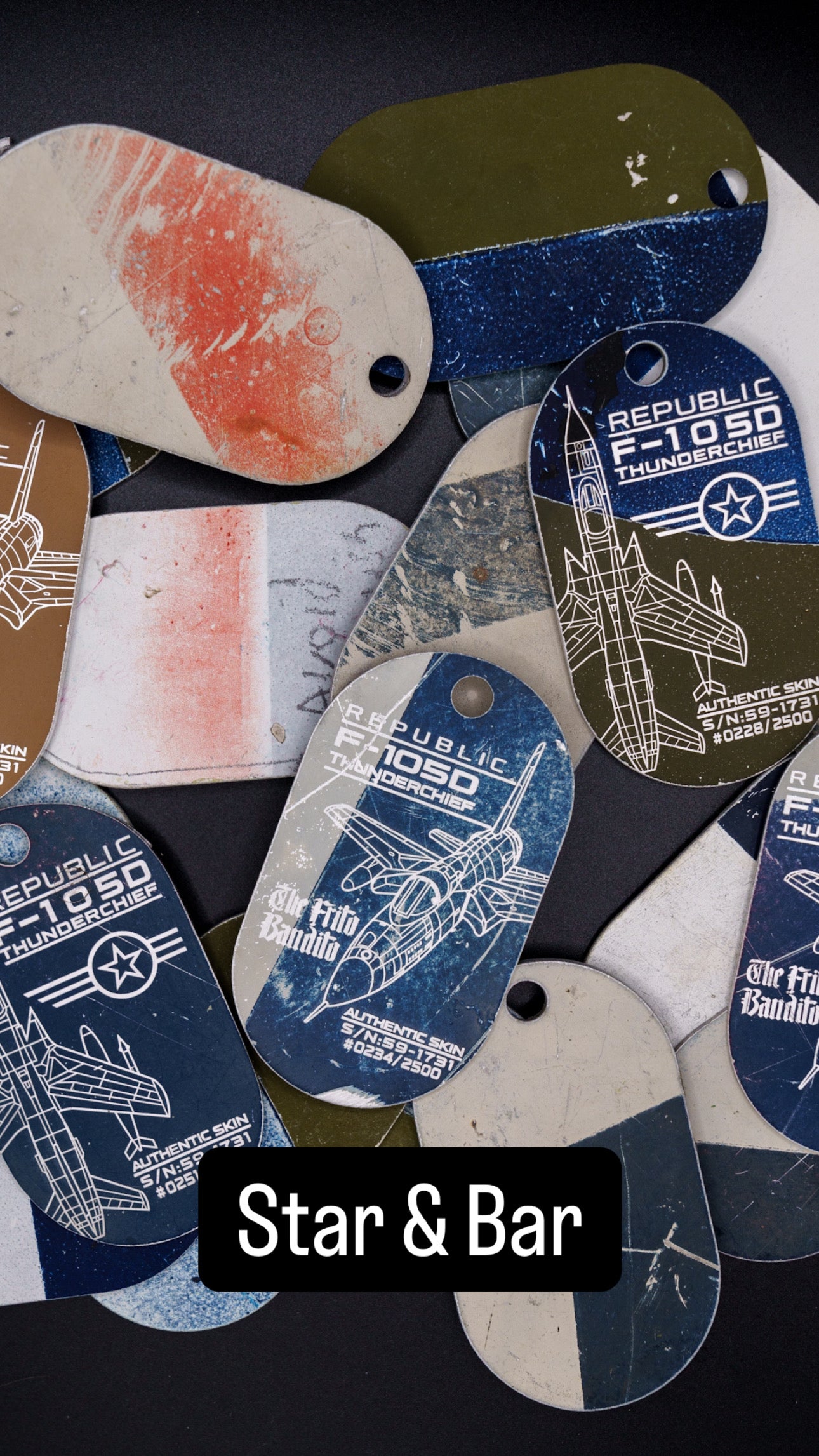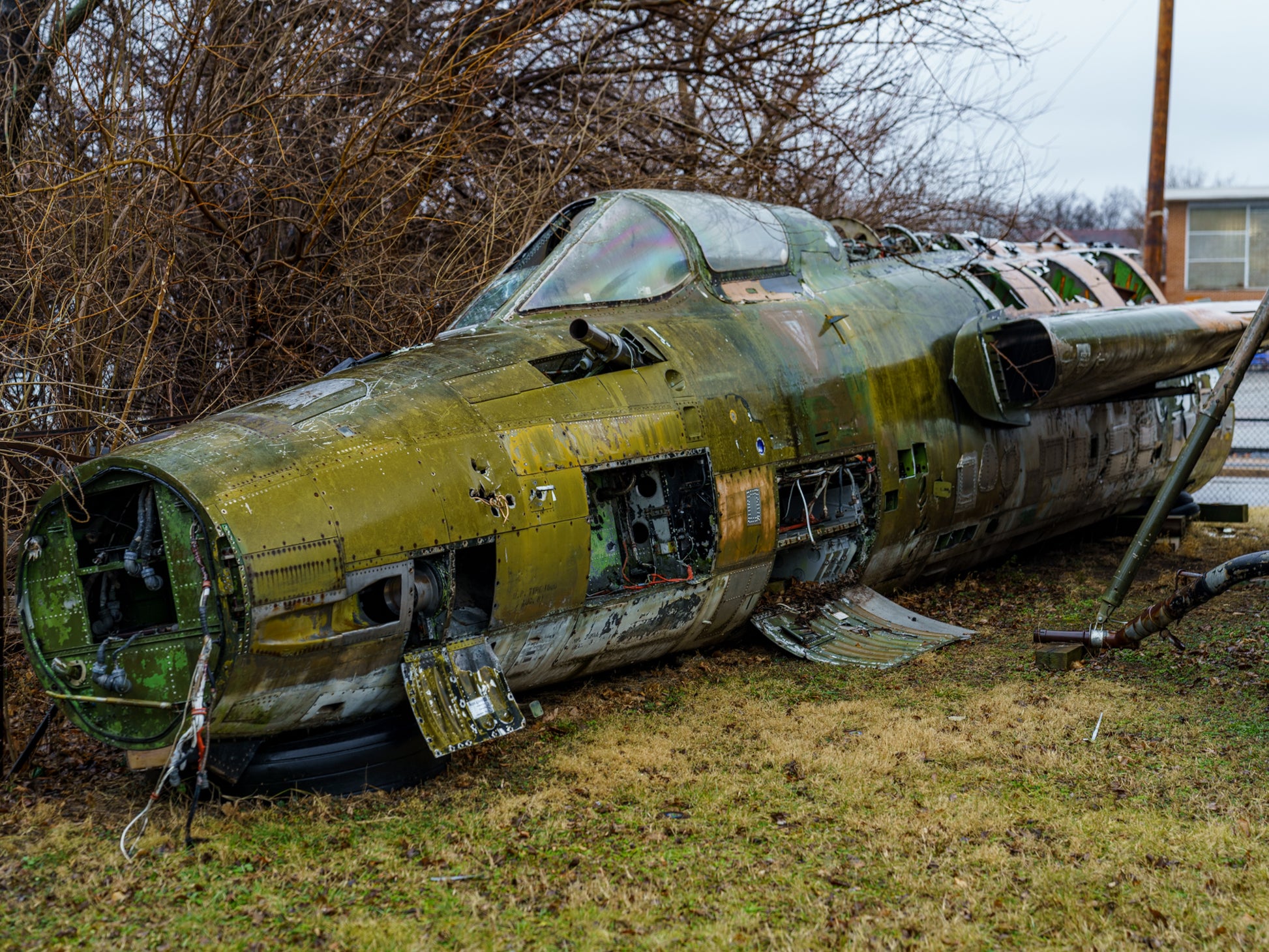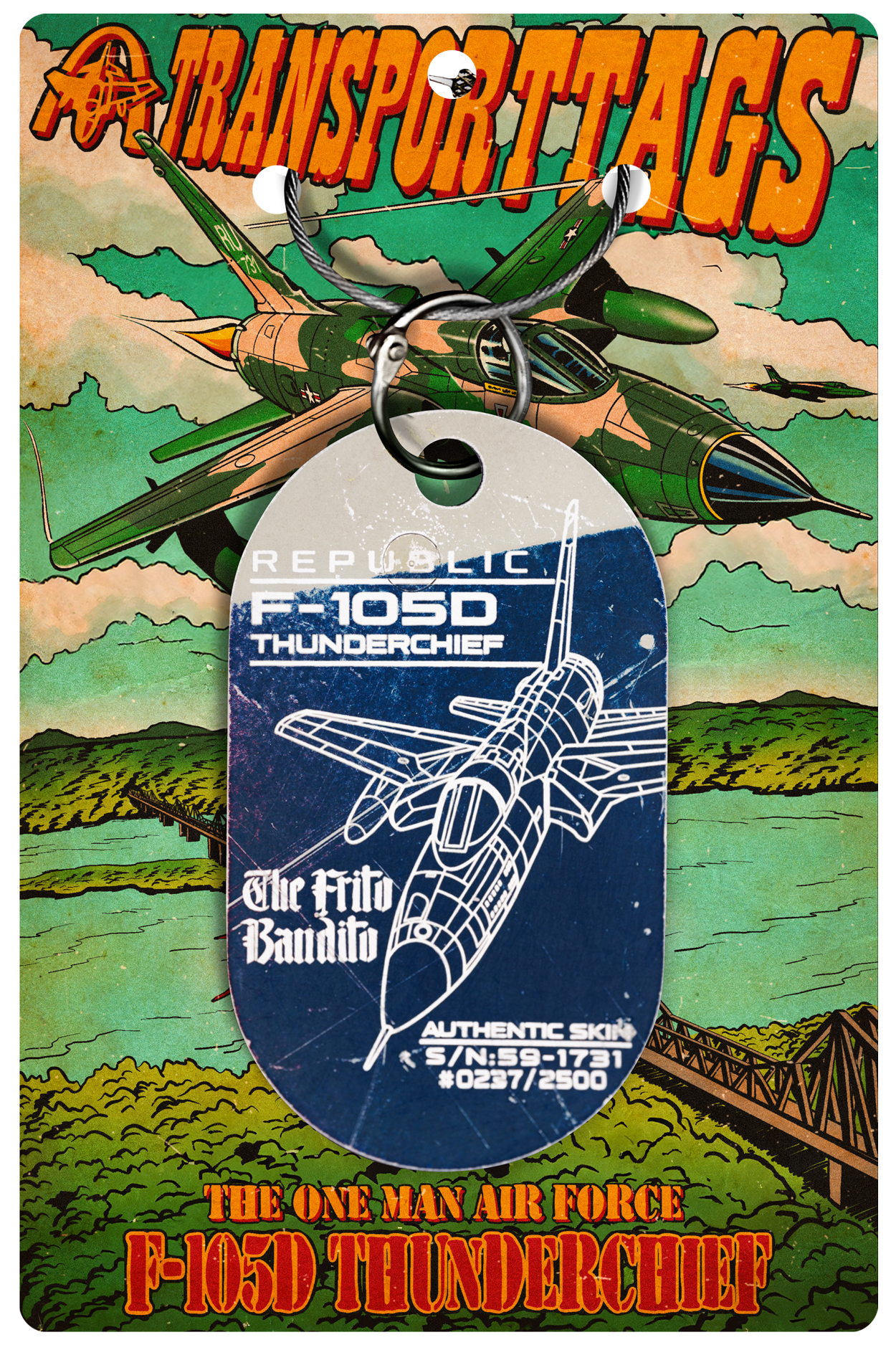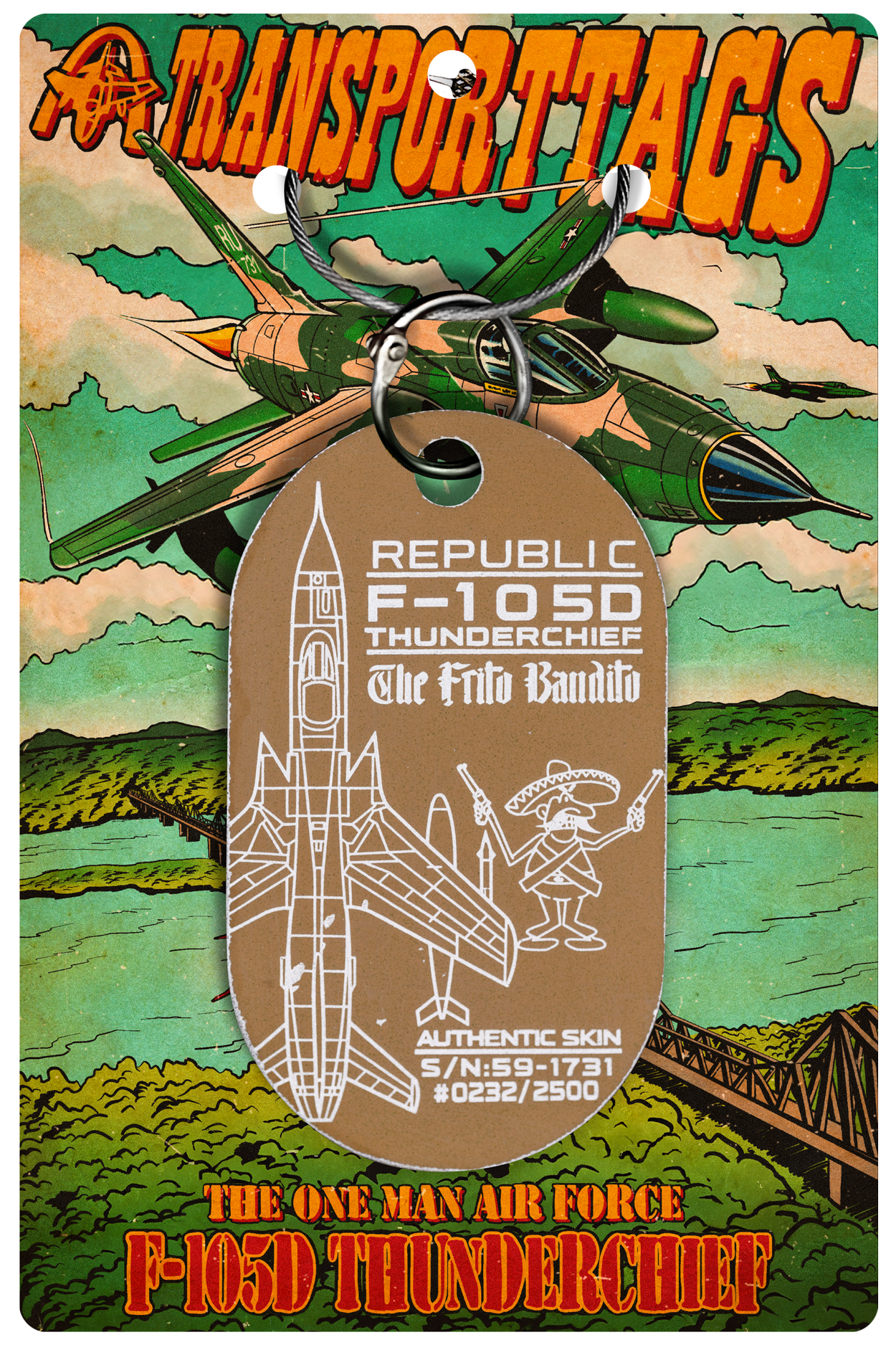F-105D Thunderchief
F-105D Thunderchief
Couldn't load pickup availability
Our F-105D Thunderchief tag is proudly handcrafted from the skin of an F-105D Thunderchief that saw significant combat during the Vietnam War.
One of our most prized possessions is the F-105D Thunderchief - Serial #59-1731 - an aircraft steeped in rich combat history. This remarkable Thud is a prolific USAF veteran of the Vietnam War. Formerly bearing the callsign "The Frito Bandito," it was piloted by Major Jose Olvera and Crew Chiefed by Doug Harried during its tenure in the Vietnam War. One of its most notable missions involved the bombing of the Paul Doumer Bridge, now known as the Long Biên Bridge, which serves as a vital link between Hanoi and the port of Haiphong.

Image provided by Crew Chief Doug Harried of him talking to Major Jose Olvera at The Royal Takhli Airbase before it went on the mission to bomb the Paul Doumer Bridge.
Doug Harried served as the crew chief for our F-105, affectionately named "The Frito Bandito," during the Vietnam War. Initially, Doug was the crew chief for a different F-105, which was tragically lost on a combat mission. After this incident, he was assigned to our aircraft S/N: 59-1731. His expertise and dedication were invaluable in maintaining the plane's readiness for combat missions. Doug's role was crucial in ensuring the success and safety of the operations involving "The Frito Bandito." Read his story here.
On arguably its most famous mission, “The Frito Bandito” sustained flak damage to its wing while diving on the Paul Doumer bridge during the bombing run. Frito Bandito also had encounters with North Vietnamese MiGs over the skies of Hanoi, even engaging in a dogfight. Throughout the Vietnam War,"The Frito Bandito" was a part of the 388th & 355th Tactical Fighter Wings, and was stationed at both Korat & Takhli Royal Thai Air Force bases in Thailand.

Image provided by Crew Chief Doug Harried who in 1970 provided his camera to another Thunderchief pilot to take the picture of “The Frito Bandito” during a strike mission.
Following its tenure in the Vietnam War, our F-105D was reassigned to the Virginia Air National Guard in 1971 and was shortly thereafter rechristened as "The Huns Hammer," and continued to serve until 1981. Following Virginia Air National Guard service, it was transported to AMARC in Tucson, AZ for storage in 1981.

After about 15 years of retirement at AMARC, 59-1731 was put up for auction by the DRMO along with another F-105 we acquired, 60-0452, known as “Rebel Rider”. Shortly after winning the auction in the mid 1990s both aircraft were transported to St. Louis, Missouri for storage and restoration work.

We plan to complete a full static restoration of F-105D S/N 60-0452, known as 'The Rebel Rider,' as it appears in the image above, prior to restoration.
We have embarked on a restoration project for the whole aircraft of 60-0452, while portions of 59-1731 have been artfully upcycled for our TransportTags so you can own a piece of a legendary aircraft with epic combat history! However, we are not decimating the legendary “Frito Bandito” and are dedicated to preserving the cockpit.

We plan on restoring the cockpit of 59-1731, formerly “The Frito Bandito”, as pictured above, and will use part of the proceeds from TransportTags to complete the restoration of both our F-105s.
Our aim is to ensure that future generations have the opportunity to appreciate these extraordinary pieces of history. The story of our F-105D Thunderchiefs is a testament to the monumental journeys that such warbirds can have, transitioning from active service during a large scale conflict to a life showcasing living history both via our TransportTags and the future display of our legendary Thuds.

Vehicle History
Vehicle History
The F-105 Thunderchief - often referred to as the "Thud" - is a significant piece of combat aviation history. Developed by Republic Aviation and designed by Alexander Kartveli, the mind behind many other notable aircraft such as the P-47 Thunderbolt and F-84 Thunderjet, the F-105 took its maiden flight in 1955. Notably, it was the largest single-seat, single-engine combat aircraft in history to be utilized by the United States Air Force.

In its early stages, the F-105 was envisioned as a nuclear strike aircraft. However, it eventually became an integral part of the US conventional bombing forces during the Vietnam War. The aircraft was particularly known for its advanced avionics, including a pioneering radar system which was predominantly featured in the all-weather fighter-bomber F-105D variant.
The F-105 Thunderchief played a crucial role in the Vietnam War. It undertook the majority of strike bombing missions against targets in North Vietnam - dropping approximately 75% of all bombs from 1964 to 1968. The F-105s were tasked with hitting a variety of targets, including infrastructure, military installations, and SAM sites (surface to air missiles). Furthermore, it was used for dropping napalm on enemy troop concentrations.

“The Frito Bandito" taxiing on the runway before a strike mission.
In addition to its bombing capabilities, the F-105 also exhibited a decent performance in dogfights. It is credited with downing 27 ½ MiGs during its time in Vietnam. Moreover, the F-105 Thunderchief could carry nearly twice the payload of a B-17 bomber from WW2, which earned it the nickname “bomb truck” in Vietnam.
Despite enduring heavy losses during the Vietnam War (382 Thuds were lost over Vietnam) the F-105 received praise for its speed, rugged survivability, bomb payload capacity, and its ability to hold its own in a dogfight with highly maneuverable MiG fighters. The Thud's service was instrumental in shaping the outcome of many battles in the Vietnam War. It is a testament to the aircraft's true resilience and adaptability, demonstrating the vital role of air power in modern warfare.

In addition to its distinguished service in Vietnam, the F-105 played a pivotal role across Europe during the peak of the Cold War. F-105s were strategically deployed throughout Europe, serving as potent symbols of nuclear deterrence. Their presence represented a constant reminder to the Soviet Union of the formidable strike capabilities that would be activated in the event of an attempted invasion of Western Europe. The Thuds, with their imposing presence, were therefore not just war machines, but also instruments of diplomatic strategy during a critical period in global history.
The F-105 Thunderchief was officially retired from the United States Air Force in 1984 following a phased withdrawal that began in 1980. Its distinguished service during the Vietnam War as the primary strike bomber has etched its legacy into military history. Additionally, its presence in Europe during the Cold War served as a potent symbol of Western/NATO defense capabilities, effectively deterring potential Soviet aggression. Even after retirement the Thunderchiefs contributions to combat aviation continue to be well revered and commemorated.
Our F-105D Thunderchief, the "Frito Bandito," has a rich combat history, notably in the Vietnam War, and later served as the "Huns Hammer" with the Virginia Air National Guard.

Crew chief Doug Harried inspecting “The Frito Bandito" at Royal Takhli airbase in Thailand
Producing these tags is not only a way to raise funds for restoration, but also a way to share these pieces of aviation and transportation history with you. We see it as a partnership and truly appreciate your business. We are excited to be able to share such an amazing piece of aviation history with you - The Thunderchief TransportTag.
Product Specifics
Product Specifics
- Double Thick tags can come in green or tan.
- Tags will not come with a reverse-side engraving unless a custom engraving is selected. This is due to a limited number of engraveable tags for this release.
Vehicle Stats
Vehicle Stats
| Engine | Pratt & Whitney J75-19 Afterburning Turbojet Engine | |||
| Top Speed | 1390mph / 2240kph (Mach 2.1 @ 35,000ft) | |||
| Ceiling | 51,000 ft (15,545m) | |||
| Length | 64’ 5” (19.63m) |
|||
| Wingspan | 34’ 11” (10.64m) | |||
| Max Payload | 14,000 Lbs. (6350 kg) |
|||
| Kills | Credited with 27.5 | |||
| Armament |
|
Product Dimensions
Product Dimensions
Card Dimensions
Length: 5 1/2"
Width: 3 1/2"
Tag Dimensions
Length: 3"
Width: 1.75"
Thickness: 1.3mm - 6.8mm
Disclaimer
Disclaimer
TransportTags are unique, handcrafted pieces made from genuine vehicle skin. Features like scratches, blemishes, or minor discolorations testify to their unique vintage appeal and authenticity. By purchasing, you accept the product may differ slightly from website images. Transport Tags LLC uses authentic material from transportation vehicles, potential containing hazardous substances. Not intended for ingestion, inhalation, or use by small children. Transport Tags LLC is an independent company, not affiliated with, sponsored or endorsed by any entities. We use branded names and insignia for identification under the provisions of the Lanham Act, without implying any association or endorsement. For more information, read our detailed product safety and legal information here.
Share








































